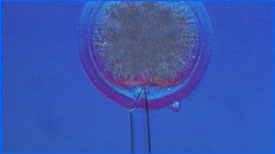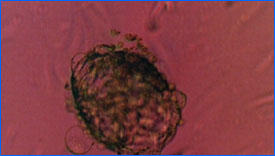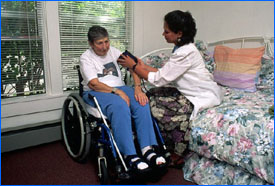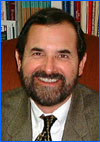|
 |
 |
|
The Stem-Cell Debate
Part 2 | Back to Part 1
Moral seasoning
Regarding the second issue I mentioned above - that of derivation of PSCs—presuming
that at least initially such stem cells will likely come from discarded human
embryos from IVF clinics, then research or no research, the embryos will be
destroyed. This means they will be thawed and eventually incinerated or
otherwise discarded. British infertility clinics, in the course of performing
their legally mandated duty of discarding 3,300 unwanted or unclaimed embryos,
are reported to have thawed and administered a few drops of alcohol to each
embryo before incinerating them. It would seem that even for those who oppose
embryo destruction, the morally relevant conduct here is the destruction, not
how it is accomplished. Once one has set about destroying an early embryo, it
seems immaterial whether this is done by thawing and allowing it to die in a
petri dish, by dropping it into a lethal solution, or by using a micropipette
to disaggregate it.
|
No one denies that early embryos lack sensory organs or tissues. They cannot suffer pain.
|
No one denies that early embryos lack sensory organs or tissues. They cannot
suffer pain. Their moral worth, if any, resides in their potential for further
development. The "wrong" here (if there is any wrong at all) is the ending of
that potential, not how it is ended. Downstream researchers may thus be
involved in encouraging clinicians and others to adopt a particular
method of embryo destruction, but that is morally unimportant. They are
in no way involved in encouraging the destruction itself, which will occur in
any case. That is, downstream researchers would merely be encouraging adoption
of a morally neutral method that is most likely to produce some benefit from an
otherwise unavoidable situation of loss.
 If ES cells come
from rejected IVF embryos slated for imminent destruction, Green feels that the
potential benefits of stem-cell research outweigh right-to-life
concerns.
If ES cells come
from rejected IVF embryos slated for imminent destruction, Green feels that the
potential benefits of stem-cell research outweigh right-to-life
concerns.
|
|
Working through these thoughts, I had no illusions that this approach would end
the controversy over ES cell research. Some people would continue to abhor even
the most remote connection with what they regarded as evil deeds. Others would
see symbolic issues within these debates that threatened the sanctity of human
life. They would see the involvement of researchers in the killing of a form of
human life as a dangerous precedent that outweighed the benefits of ES cell
research.
Though I appreciated these concerns, I did not see them as outweighing the
possible benefits of ES cell research. I believed that many people who hold a
different view of the early embryo's status than I do could share my
conclusions about using embryos that would otherwise be destroyed. My aim was
to develop a position that could attract enough support from a middle ground to
shape public policy. The challenge was to understand the issues sufficiently to
determine which analogies, precedents, or illustrations best conveyed their
underlying logic. Once that determination was made, one could identify those
arguments most likely to convey the issues honestly and effectively to a larger
audience.
|
The image of researchers dissecting tiny human beings
should not be allowed to dominate the discussion.
|
Simultaneously, one could better understand the force of one's opponents' views
and how to respond to them. The image of researchers dissecting tiny human
beings should not be allowed to dominate the discussion. The public had to
understand that the key issue was whether spare embryos would be used for
valuable research that could save human lives or would merely be thrown away.
This was not a matter of countering one emotionally evocative image with
another. Rather, it was an attempt to articulate the real nature of the choices
and their most likely moral implications.
Down the road
Future
developments may erode the emphasis on spare embryos implicit in the
use-versus-derivation distinction. As I have argued, the moral logic of
separating use from derivation rests on the fact that the needed embryos can
come from the population of those embryos left over from infertility procedures
that will otherwise be destroyed. However, we can already imagine a future in
which it may be desirable deliberately to create embryos in order to produce
autologous pluripotent stem cell lines. This is the prospect I sketched earlier
of using a somatic cell from an individual to produce an embryo (via somatic
cell nuclear transfer technology), and from this embryo, a histocompatible ES
cell line for cell-replacement therapy.
 At the moment,
the notion of creating new ES cell lines using human embryos fashioned by means
of "therapeutic cloning" is fraught with moral and technical
uncertainties.
At the moment,
the notion of creating new ES cell lines using human embryos fashioned by means
of "therapeutic cloning" is fraught with moral and technical
uncertainties.
|
|
Before "therapeutic cloning" of this sort becomes a reality, and certainly
before it merits federal research support, many questions will have to be
asked. Is it really not possible to avoid this alternative by manipulating
immunity factors in existing pluripotent stem cell lines produced from spare
embryos (research that could be done with federal dollars)? Does the actual
bench research in this area need federal support and oversight, or is it
something that can be accomplished effectively with private funding? And if
this possibility becomes a clinical therapy, will it need federal support, or
can it be offered as a purchased clinical service?
The answers to these questions are by no means evident. If cell-replacement
therapies using deliberately created embryos prove highly successful, we may
also have to consider issues of federal funding beyond the research context, in
the area of clinical services. Would it be just to deny Medicaid or Medicare
recipients access to these therapies merely because other citizens morally
object to them?
|  Would it be right, Green asks,
to deny, say, a Medicaid patient access to cell-replacement therapies just
because some people may morally object to them?
Would it be right, Green asks,
to deny, say, a Medicaid patient access to cell-replacement therapies just
because some people may morally object to them?
|
Fortunately, these are questions for the future. I introduce them here to
illustrate how ongoing experience can force a rethinking of moral conclusions
from one period to the next. This is exactly what happened with fetal tissue
transplantation research, support for which has been reinforced by increasing
clinical successes and the efficacy of morally sound regulations.
I must stress that there are two things I am not saying in indicating
the importance of ongoing experience and the possibility of revising our
conclusions. First, I am not suggesting that we should advocate the least
offensive research initiatives now as a political device for expanding these
initiatives later. I am not a political scientist and have no idea whether this
is the best way to proceed. I am making a moral, not a political, argument. It
is respect for others, not political efficacy, that requires the use of the
least offensive means needed at each stage of research.
Second, I am not suggesting that success makes something that is wrong right. I
personally do not believe that human embryo research, including the deliberate
creation of embryos for valid research or clinical purposes, is wrong, but I
acknowledge that many people do. I am not saying that the mere fact of
scientific or clinical success will convince these people otherwise or prove
them wrong.
Moral reasoning must always be in conversation with
human experience.
|
|
I am saying that moral reasoning must always be in conversation with human
experience. Because so many aspects of moral decision require difficult
balancing judgments often based on uncertain predictions about future harms or
benefits, it is very important to stay in touch with moral realities as they
evolve "on the ground." It may be that all the promises of human embryo or
pluripotent stem cell research will prove to be fruitless. In that case, the
urgency of this research and the justification of continued federal funding for
research will decline.
Conversely, the clinical successes may be enormous. They may also spur new
techniques for producing pluripotent stem cell lines that reduce or minimize
the need to destroy embryos. In that case, those currently opposed to these
research directions may find themselves altering their opposition to some forms
of this research. Remaining open to experience does not mean sacrificing
principles to success. It merely expresses the wisdom that as human beings we
are not omniscient or unerringly right in our moral judgments.

|
|
Dr. Ronald M. Green is The Eunice and
Julian Cohen Professor for the Study of Ethics and Human Values, Chair in the
Department of Religion, and Director of the Ethics Institute at Dartmouth
College. In 1996 and 1997, he served as the founding Director of the Office of
Genome Ethics at the NIH's National Human Genome Research Institute. This
article was adapted from Green's book, The Human Embryo Research Debates:
Bioethics in the Vortex of Controversy (Oxford University Press, 2001),
with kind permission of the publisher. |
Photos: (1-2, 6-8) WGBH/NOVA; (3-4) Courtesy of Dr. Thomson and Dr. Gearhart;
(5) Corbis Images; (9) Courtesy of Dr. Green.
Watch the Program |
The Stem-Cell Debate |
Windows on the Womb
Great Expectations |
How Cells Divide |
How is Sex Determined?
Resources |
Teacher's Guide |
Transcript |
Site Map |
Life's Greatest Miracle Home
Search |
Site Map |
Previously Featured |
Schedule |
Feedback |
Teachers |
Shop
Join Us/E-Mail |
About NOVA |
Editor's Picks |
Watch NOVAs online |
To print
PBS Online |
NOVA Online |
WGBH
© | Updated November 2001
|
|
|
|